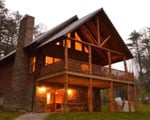CARTER CAVES STATE RESORT PARK
On July 31, 1946, the citizens of Carter and surrounding counties donated 945 acres to the Commonwealth of Kentucky for a state park. Contained in this tract are some of the most impressive caves in the state. Additional land has been obtained, making a total of some 2,000 acres. Carter and Cascade Caves are the best-known caverns in eastern Kentucky. Located in north-central Carter County, the Carter and Cascade Cave system is comprised of more than 20 caverns. Four of these caves are open for tours. Others are undeveloped or access is limited. Each cave has distinctive features reflecting geological forces.
Bat Cave is the largest cave in the park. It is open only in the summer and is the home of an estimated 40,000 Indiana bats called Myotis that hibernate there in the winter. These bats are protected by the Kentucky Parks System. The caves main passageway is a half-mile long and follows the course of Cave Branch. The ceiling of the passageway varies in height from about 35 feet at the downstream entrance to a claustrophobic 4 feet. Known as Backache Avenue, the low ceiling of the passageway extends 700 feet. This passage is wet and there are small pools of water throughout its length. During heavy rains the passage can be flooded by torrents of water.
Saltpetre Cave is a dry cave. No streams flow through these passages today. Evidence suggests that water did flow through the cave many years ago. The cave has long, broad, low-ceilings and dirt floors. The name of the cave comes from the old saltpeter works near the entrance that helped produce gunpowder during the War of 1812. Kentucky caverns had several saltpeter mines during the war. Nitrates for making gunpowder could be extracted from the earth in the caves. On the wall near the entrance is the legend, Simon Kenton 1783. Kenton, an early Kentucky pioneer, explored the area in the late eighteenth century. Saltpetre Cave is shown to visitors by guided tour.
The most popular cave for visitors in the Carter Cave system is X Cave, so-called f or the two intersecting caverns that from the letter X. Narrow and tall passageways permeate the X Cave. The walls of the cavern have been carved by water. X Cave is filled with beautiful and strange forms. Stalactites and stalagmites are found along the right passage of the cave. Columns, draperies, and flowstone created by centuries of water percolating through earth and stone, decorate portions of the cavern. Giant Stalactite is the largest dripstone formation in the cave. This formation of several stalactites is seven feet in diameter and about30 feet high. Another curiosity is Pipe Organ. This formation is unique in that several stalactites and draperies, when struck with a piece of wood, sound different tones, thus giving it its musical instrument name.
In 1959 Cascade Cave, once privately owned and operated, became a part of the Carter Cave State Park System. Shown to visitors since 1925, the cavern is made up a series of parallel passages. They are filled with dripstone formations of different types. The entrance to Cascade Cave is located on the side of one of the many sinkholes in the area. Highlights of the cavern include Counterfeiters Room named for the supposed use of the cave by counterfeiters. The Lake Room is so-called for the large pool of water located there. Other interesting points in and around Cascade Cave are Cathedral Room, The Hanging Gardens of King Solomon, Cardross Castle, Ice capped Mountains, and Temple Bells. Cascade Cave also has a beautiful 30 foot underground waterfall.
Carter Caves State Park has several natural bridges. Smokey Bridge is the largest natural bridge in Kentucky. Carter Cave Natural Bridge is the only one in the state with a paved road on top.
Although established as a state park in 1946, funding for Carter Caves did not occur until 1948. Between 1948 and 1955, the state spent $600,000 to create one of the most beautiful parks in the commonwealth. The construction of 45-acre Smokey Lake for fishing and boating added to the attractions of the park. Between 1960 and 1968, the state spent $900,000 to make Carter Caves one of the best resort parks in the system. Improvements at the park included the construction of Caveland Lodge, a nine-hole regulation golf course, miniature golf, picnic areas, and a number of other improvements.
Enjoy the seclusion of a beautiful two-bedroom cottage. Eleven are available 10 have 4 queen beds and 1 has 4 double beds. The newly-built structures offer modern conveniences such as automatic dishwashers and microwave ovens along with covered decks that offer scenic views of the parks wooded hills. Ten of the eleven cottages have two bathrooms. Nine have wood-burning fireplaces. Tableware, cooking utensils and linens are provided with fresh linens available daily. Cottages available by late afternoon. Check out by 1000am, local time. Click here to review our lodging guidelines.
Enjoy the great outdoors The campground features 89 campsites including 30 tent sites with utilities, a dump station, and two central service buildings with rest rooms and showers. The tent sites do not have water or electric. Closed for season from November 15 to mid-March 15.
Carter Caves offers 8 pull-through campsites specifically designed for horse owners. These sites feature electric, water and sewer hook-ups. Each site has its own corresponding hitching posts for up to four horses, picnic table, lantern hanger fire ring/grill combo. Horse campers have access to all campground amenities, which include bathhouses, laundry area and playgrounds. Riders can enjoy 12 miles of multi use trails, accessible from the horse camp.
Open all year.
This beautiful fieldstone lodge offers 28 rooms with full amenities.
Each room features a private balcony or patio overlooking the surrounding woodlands. Rooms available by late afternoon. Lodge room check-out by 1100am, local time. A limited number of lodge rooms will be available for pets. High speed wireless internet service available at the lodge.



